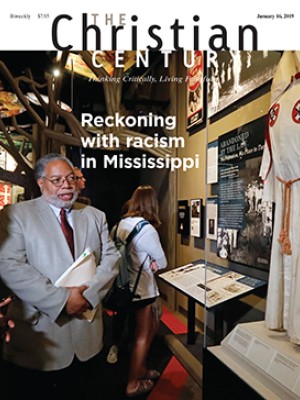The Crystal Cathedral is still a cathedral, but soon a Catholic one
Once the symbol of evangelist Robert Schuller’s success, the 128-foot-tall glass building went into foreclosure and the Diocese of Orange bought it.
For nearly 30 years, Robert Schuller’s Crystal Cathedral was not only a religious landmark but an architectural wonder and an embodiment of flush times in Southern California’s Orange County.
Schuller, who died in 2015, was one of the most widely known pastors in the Reformed Church in America. He captured the ebullient positivity of midcentury America, and by the 1970s he was one of the country’s top televangelists, broadcasting Hour of Power.
The symbol of his success was the Crystal Cathedral, a 128-foot-tall building designed by the modernist architect Philip Johnson to be the largest glass building in the world. It was a physical representation of the limitless hopes of the evangelical community of the time.
Read our latest issue or browse back issues.
But the landscape began to change. At the turn of the 21st century, Schuller’s large following of white evangelicals was aging, and the population of nonwhite residents in California was increasing. Membership and donations to the Crystal Cathedral began to decline. The cathedral filed for bankruptcy in 2010.
At the same time, the Roman Catholic Church started seeing an increase in attendance in Southern California. In 1976, the Diocese of Orange consisted of about 300,000 Catholics. Today, the number is closer to 1.6 million.
The Crystal Cathedral is almost ready to reopen as Christ Cathedral, seat of the Diocese of Orange. Construction is planned to finish this spring, with a dedication in the summer.
“It’s the carrying on of a legacy that was begun before us,” said Christopher Smith, a priest at Christ Cathedral. “And a very important sign of Christian unity.”
In fall 2011 Hank Evers, director of strategic communications for the Diocese of Orange, was working on a capital campaign aimed at raising at least $200 million to build a replacement for Holy Family Cathedral, an early 1960s parish church that was selected as the diocesan seat when the Diocese of Orange split off from the Diocese of Los Angeles in the 1970s.
It was that winter that the Crystal Cathedral was foreclosed on and bidding opened up for the campus, including 35 acres, seven buildings, and 340,000 square feet of building space.
“Buying a used cathedral,” Evers said, was uncharted territory.
For one thing, the Diocese of Orange wasn’t even the highest bidder. But at Schuller’s request, the bankruptcy judge awarded the Diocese of Orange the property for $57.5 million.
Then came the hard part. The Crystal Cathedral needed major repairs and would have to be adapted to serve as a Catholic facility. The new focus of Evers’s capital campaign was raising money for its transformation. The final figure was $25 to $30 million over budget.
The diocese brought in Richard Heim, division CEO for Clark Construction Group and a local Catholic. By cutting back on construction costs for what Heim refers to as “back of the house” features that few worshipers would notice, the diocese was able to save millions of dollars. The total cost of acquiring and adapting the building, at a little more than $100 million, came to about half that of building a new cathedral.
“We had to strike a balance between the architectural significance, the functionality of the space, but also bring it in within the available funds,” Heim said. “It is not the traditional stone concrete cathedrals that you would see in Europe that would last 500 years.”
The rehabilitation crew ran into a lot of unexpected challenges. The entire glass facade and roof had to be recaulked to withstand an earthquake.
To transform the building into a place for Catholic mass, a substantial altar area replaced Schuller’s pulpit, giving it a central place in the cathedral. Limestone walls have been erected to create a sense of enclosure, and 11,000 panels hung toward the ceiling help control temperature, monitor the acoustics, and create a more somber atmosphere. The Hazel Wright organ, one of the largest church instruments in the world, named for the Hour of Power viewer who donated the money for it, has been moved to the side.
Some architecture critics have taken exception to the changes, saying they diminish the openness of the design. But the diocese feels that it has done much to preserve the beauty of the cathedral while accommodating the diocese’s needs.
The diocese currently hosts 12 masses in four languages every Sunday in another building on the campus. In the main building, which seats nearly 3,000, Smith and other staff will likely decrease the number of masses each Sunday to make sure pews are fuller.
“If the closest person to you is five to ten pews behind you, it doesn’t create a very strong spirit of participating with other people,” he said.
Smith recalls being six years old and watching Schuller with amazement. “Never did I imagine,” Smith said, that more than “60 years later, I would meet this preacher”—and be part of keeping Schuller’s legacy and Christianity at the heart of the building.
Smith notes that Catholic activist Dorothy Day emphasized the need for beautiful spaces and encouraging the rich and the poor to come inside, listen to the music, look at the art, and be inspired.
“Food is part of what we need to keep alive as humans but we also need to nourish our spirits,” Smith said. “Beauty is one of the things that does that.” —Religion News Service
A version of this article appears in the print edition under the title “The Crystal Cathedral is still a cathedral, but soon a Catholic one.”






